![]()
|
Frederick
Winkle & Co |
|
Location and period of operation:
|
F Winkle
& Co |
Stoke |
1890 |
1931 |
Earthenware manufacturer at the Colonial Pottery, Whieldon Road, on the border of the pottery towns of Fenton and Stoke, Stoke-on-Trent, England
|
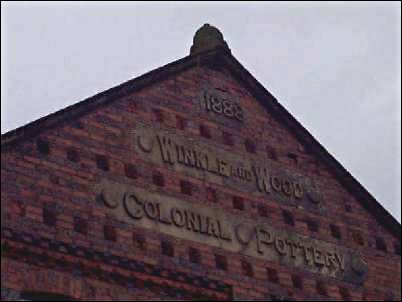 1888 Winkle and Wood Colonial Pottery |
The London Gazette 15 October 1889
|
|
![]() 1893 trade
journal article on Winkle
1893 trade
journal article on Winkle
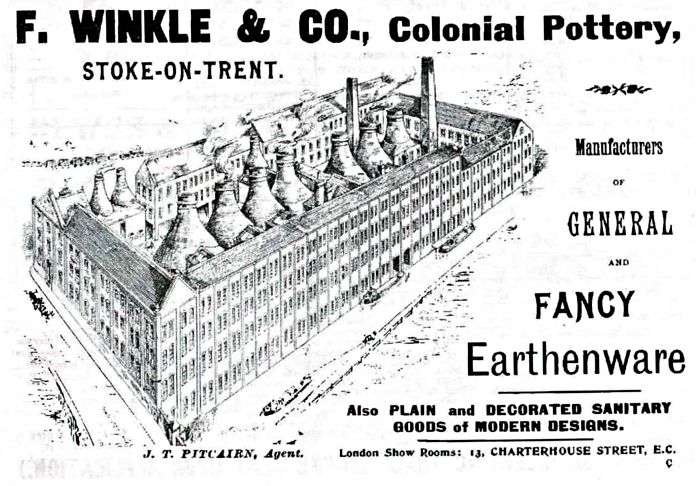
F. Winkle & Co Ltd
Colonial Pottery, Stoke-on-Trent
Manufacturers of General and Fancy Earthenware
also Plain and Decorated Sanitary Goods of Modern Design
The Pottery Gazette Diary - 1896
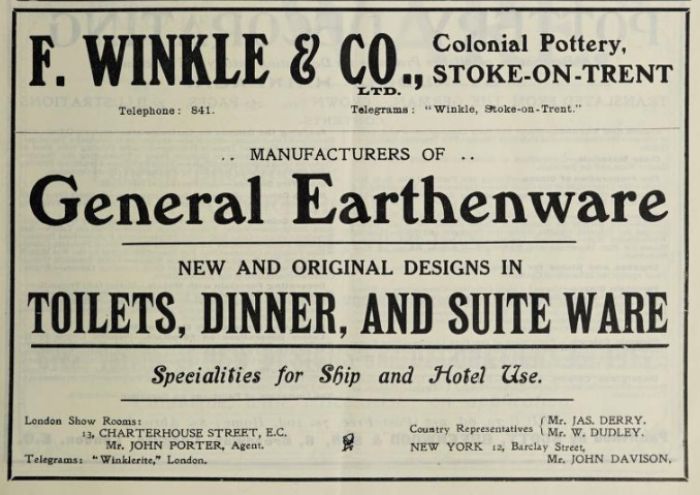
F. Winkle & Co Ltd
Colonial Pottery, Stoke-on-Trent
Manufacturers of General Earthenware
New and Original Designs in
Toilets, Dinner, and Suite Ware
Specialities for Ship and Hotel Use
The Pottery Gazette - 1st January 1913
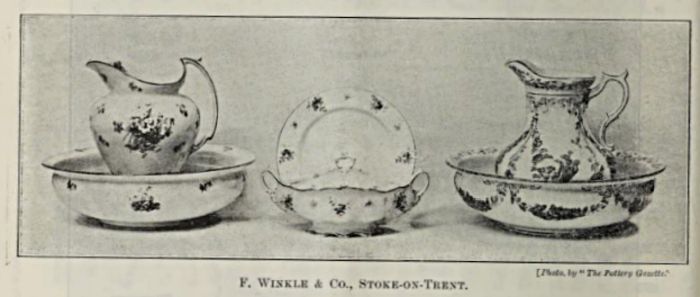
|
"Mr. John Porter has been appointed the London representative of this firm, in succession to the late Mr. J. T. Pitcairn. The fine showrooms at 13, Charterhouse-street, E.C., are continued. They are on the ground floor, and are open every day. The company are manufacturers of dinner and toilet ware, pedestals and pots, vases, fancy goods, &c. (The firm are also manufacturers of closets, lavatories, and other sanitary wares of the most improved types. Mr. W. J. Bowring has charge of this department in London, and samples are on show at the same rooms, 13, Charterhouse-street, E.C.) Mr. F. Winkle, the head of the firm, is one of the best-known men in the Potteries, and the "Colonial Pottery" and its products are familiar to dealers all over the kingdom, it may be said in nearly all the markets of the world. Mr. Winkle is a practical potter, and still exercises a general supervision over the entire works. There cannot be any doubt that the constant improvement in the firm’s productions is due largely to his intelligent oversight. The samples shown at the London rooms are evidence of his energy and enterprise. There is a fine array of pedestals and pots, many of them of noble proportions, and all tastefully modelled and skilfully ornamented. There are several severely classical forms amongst them, while others of modern design are excellent specimens of artistic pottery. Effective colouring is one of the strong features in these goods ; some very rich decorations in blue and gold are cases in point. Toilet ware is another branch of pottery in which Messrs. Winkle hold a high position, one side of the long showroom presenting a varied selection of shapes and decorations in this line. We give an illustration of two of these: one, the "Elgin," has a tall ewer, a good form which lends itself to many styles of decorative treatment. The illustration shows it decorated with violets and gilt. The other ewer and basin shown represent the "Plain Louis" shape, a nice form, not so tall as the "Elgin." The ornamentation shown is a neat arrangement of flowers and festoons. The "Peerless" and the "Ripley" are amongst other new toilet shapes. From a large number of very good dinner patterns we have selected the "Albion" shape, of which we illustrate a vegetable dish and a dinner plate. The cover dish is a pleasing oval shape, with sunk lid. The decorations include many excellent border patterns, with and without coloured bands. The firm are now making a variety of vases and other art shapes, richly decorated. There are many ranges of these, and they exhibit great diversity in outline and ornament, and all are good. The firm are showing art flower pots in an almost endless variety of designs, with tasteful embossments and nice bright colourings. Hanging pots are also shown in many patterns. In fancy goods some quaint Dutch subjects are introduced as decorations on jugs, &c." The Pottery Gazette August 1, 1907. pp922-3 |
|
VERSAILLE is the pattern name |
photos courtesy: Oak Leaf Antiques.
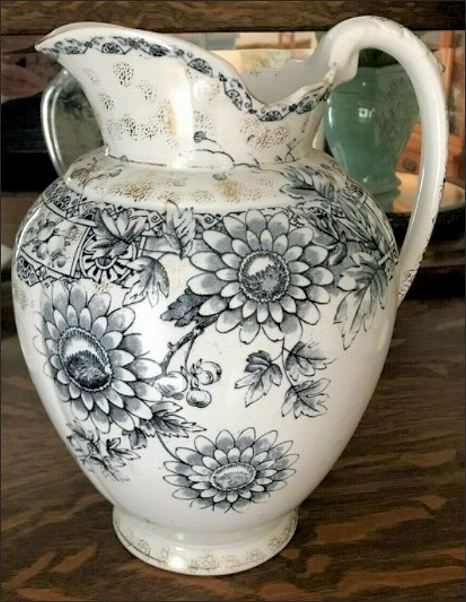 transferware jug in an aesthetic style pattern |
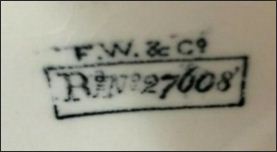 F W & Co the registration number 27608 shows that the pattern was originally registered on the 30th May 1885 to Wood, Hines & Winkle at the Pearl Pottery, Brook Street, Hanley |
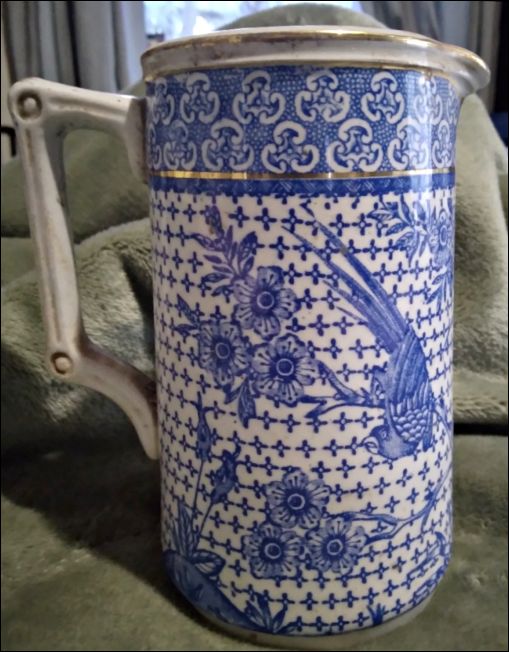 transferware jug in an aesthetic style pattern - it is described as "stylised flowering shrubs with parrots perched in the branches over a star ground, borders of bands of daisy heads" (Northern Ceramic Society) |
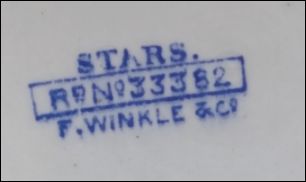 F Winkle & Co "STARS" is the pattern name the registration number 33382 shows that the pattern was originally registered on the 16th September 1885 to Winkle & Wood at the Pearl Pottery, Brook Street, Hanley |
photos courtesy: Nicolette Stoll
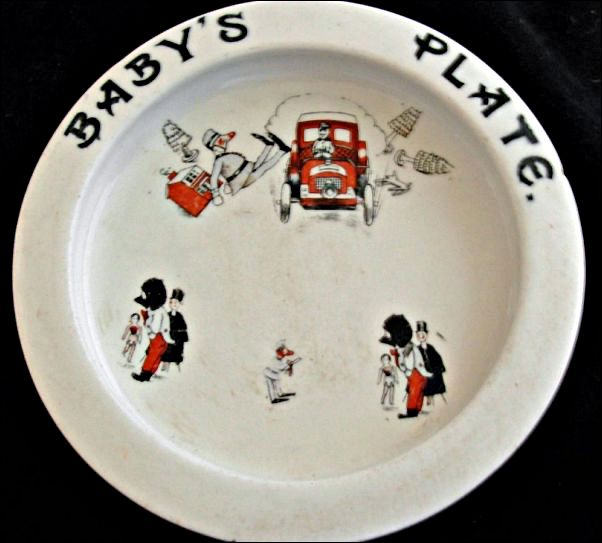
Baby's Plate
design based on one of the
Florence
Kate Upton books
showing the typical "penny wooden" dolls featured in her stories
Fenton Faience
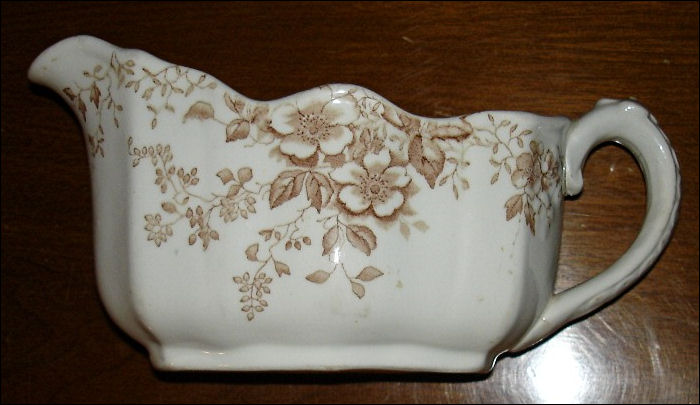
'Fenton Faience' - a sauce boat in the Surrey pattern
|
"FENTON FAIENCE" is a trade name that F. Winkle introduced in 1891 as a marketing tool. FENTON from the location of the pottery works in the pottery town of Fenton and FAIENCE after the popular European tin glazed earthenware. There were two patterns, Severn and Surrey, marketed under this trade name - both were registered on the 15th October 1891 making them amongst the earlier patterns registered by F Winkle & Co. Most of the ware in the Severn and Surrey patterns were brown printed on everyday dinner and tea sets. Occasionally the patterns were hand coloured and appeared on decorative items. |
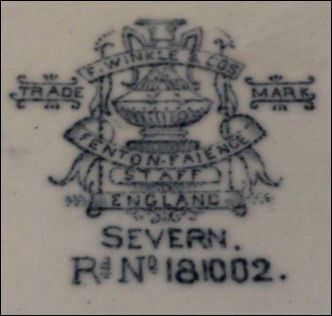 Severn Rd No 181002 The Severn pattern consists of a trailing plant with spiky leaves and five petal blooms |
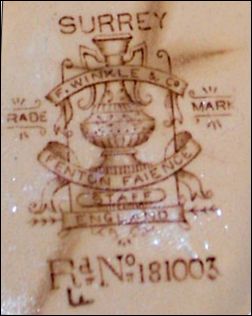 Surrey Rd No 181003 The Surry pattern has
trailing sprays of dog roses with leaves and flowers |
F Winkle
& Co
Trade Mark
Fenton Faience
Staff
England
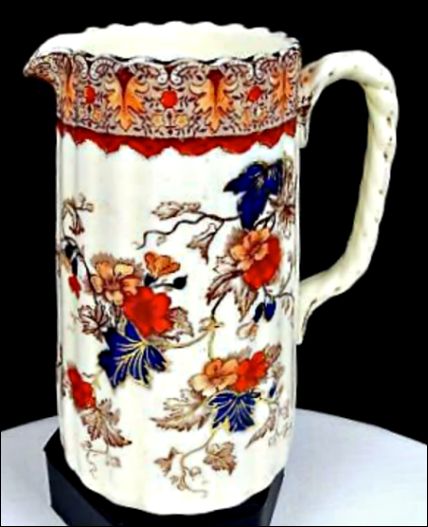 'Fenton Faience' hand coloured jug in the Severn pattern |
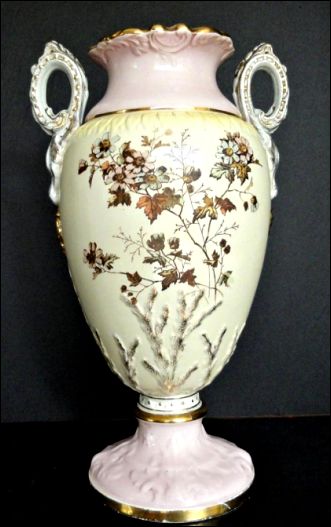 'Fenton Faience' vase with a painted background in the Surrey pattern |
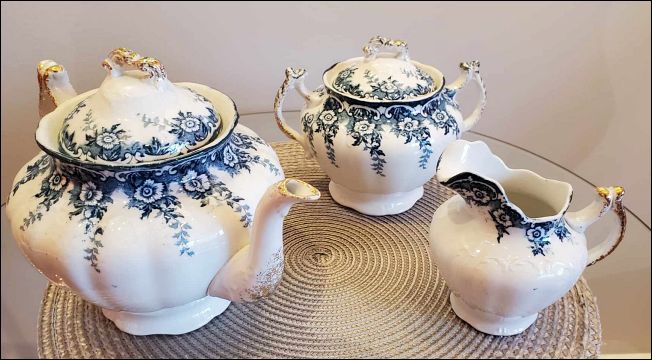 tea set in the Matlock pattern - transferware with gold accents |
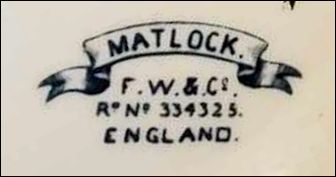 F W & Co ENGLAND the registration number 334325 shows that the pattern was registered on the 24th February 1899 |
photos courtesy: Clea Reynolds
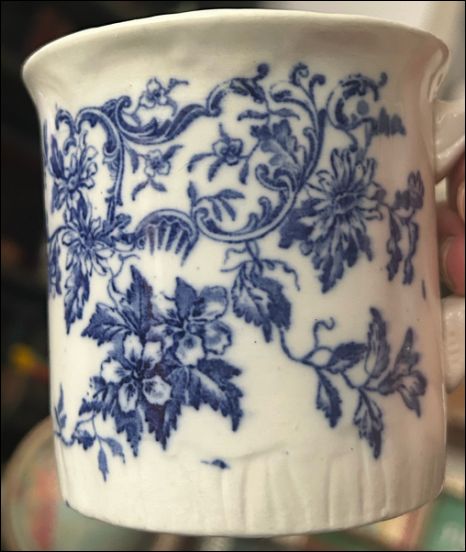 transfer decorated mug in the Shelly pattern |
c.
1890-1910 |
photos courtesy: Jen Knodell
|
this pattern was based on the very popular blue & white Asiatic Pheasants pattern |
Semi-Porcelain c.1908-11 The circular 'Whieldon Ware' mark was introduced in 1908 and continued until 1925. Generally after 1911 the '& Co' was replaced by '& Co Ltd' |
photos courtesy: Kathy Rae
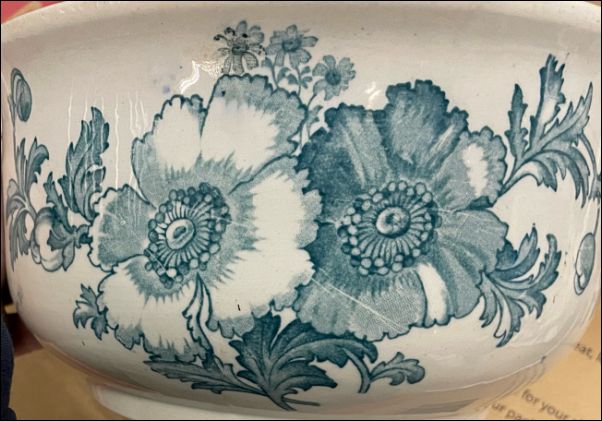 transfer decorated chamber pot in the Kingston pattern |
1911-1925 |
photos courtesy: Justin Gentle
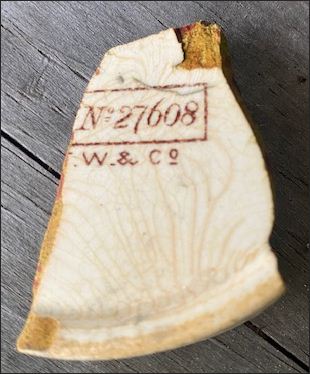
fragment bearing the F. Winkle & Co mark found
on the beach at North Haven Island, Maine, USA
the registration number 27608 shows
that the pattern was originally registered
on the 30th May 1885 to Wood,
Hines & Winkle at the Pearl Pottery, Brook Street, Hanley
photo courtesy: Kaitlyn Kirby
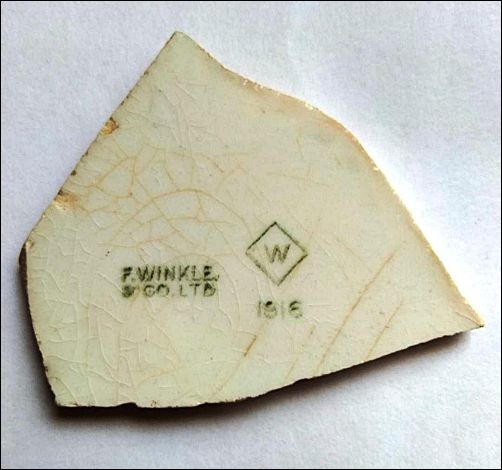
F. Winkle
& Co Ltd
W
1916
|
Shard found on the beach in Whitby, Yorkshire, England [2023] This ware was produced for and supplied to the British Government; it was ultimately property of the Crown/Government. F. Winkle (and others) were given government contracts throughout the late 1900s (WWI) and beyond and produced canteen ware - most likely for the armed services. The ‘W’ within the diamond relates to the products being commissioned and produced for the Office of Works. This mark is there to distinguish the piece from being normal ‘utilitarian’ ware for public sale or belonging to anyone organisation. |
photo courtesy: Tim Cooper
Marks & initials used on ware for identification:
F W & Co
ENGLAND
F WINKLE & CO
WHIELDON WARE
Winkle used the
trade name 'Whieldon Ware'
after the name of a famous 18th Century
potter Thomas Whieldon who
lived and worked
in this area.
The road that Winkle's Colonial Pottery was
situated on is called Whieldon Road
|
c. 1890 |
1891-1911 |
1908-1911 |
the circular 'Whieldon Ware' mark was introduced in 1908
generally 'Ltd' was added after 1911
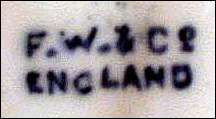 F. W. & Co England |
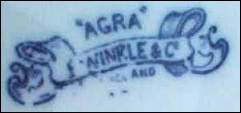 F.Winkle & Co England |
1890-1910
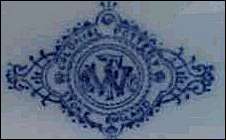 Colonial Pottery F. W. & Co Stoke England |
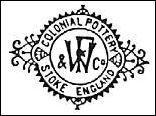
1890-1925
|
|
1908-1925 this
circular mark is usually accompanied by other marks Winkle used the
trade name 'Whieldon Ware' The road that Winkle's Colonial Pottery was |
|
1908-1911 |
1911-1925 'Ltd' was added after 1911 |
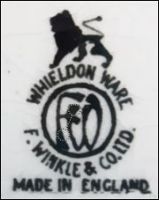
Whiledon Ware
FW
F. Winkle & Co Ltd
Made in England
1925-1931
The factory was situated alongside the Trent and Mersey canal
In the foreground is Whieldon Road.
- click for more on the Colonial Pottery -
Questions, comments, contributions? email: Steve Birks
|
Page created 11 Oct 2009 Updated 31 May 2022: Introductory details expanded; 27606 fragment added. Updated 11 May 2023: General tidy up; 1913 advert added; section on marks greatly expanded. Updated 25 Sep 2023: Government supply details and 1916 example added. Updated 31 Jan 2025: Upton 'Baby Plate' added. Updated 10 Sep 2025: Added - 1896 advert; 1907 advertorial; example of jug in the 'Stars' pattern. |